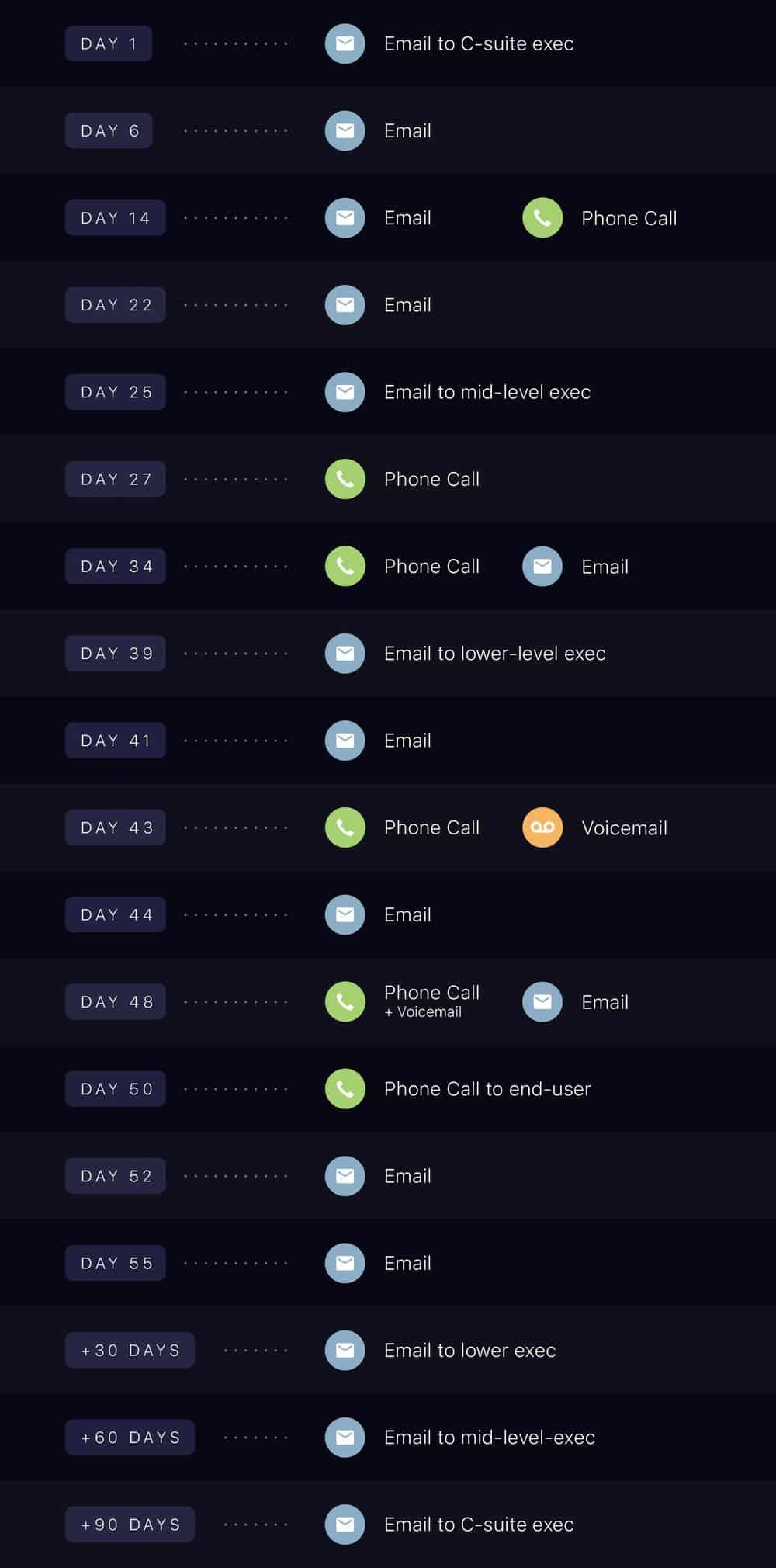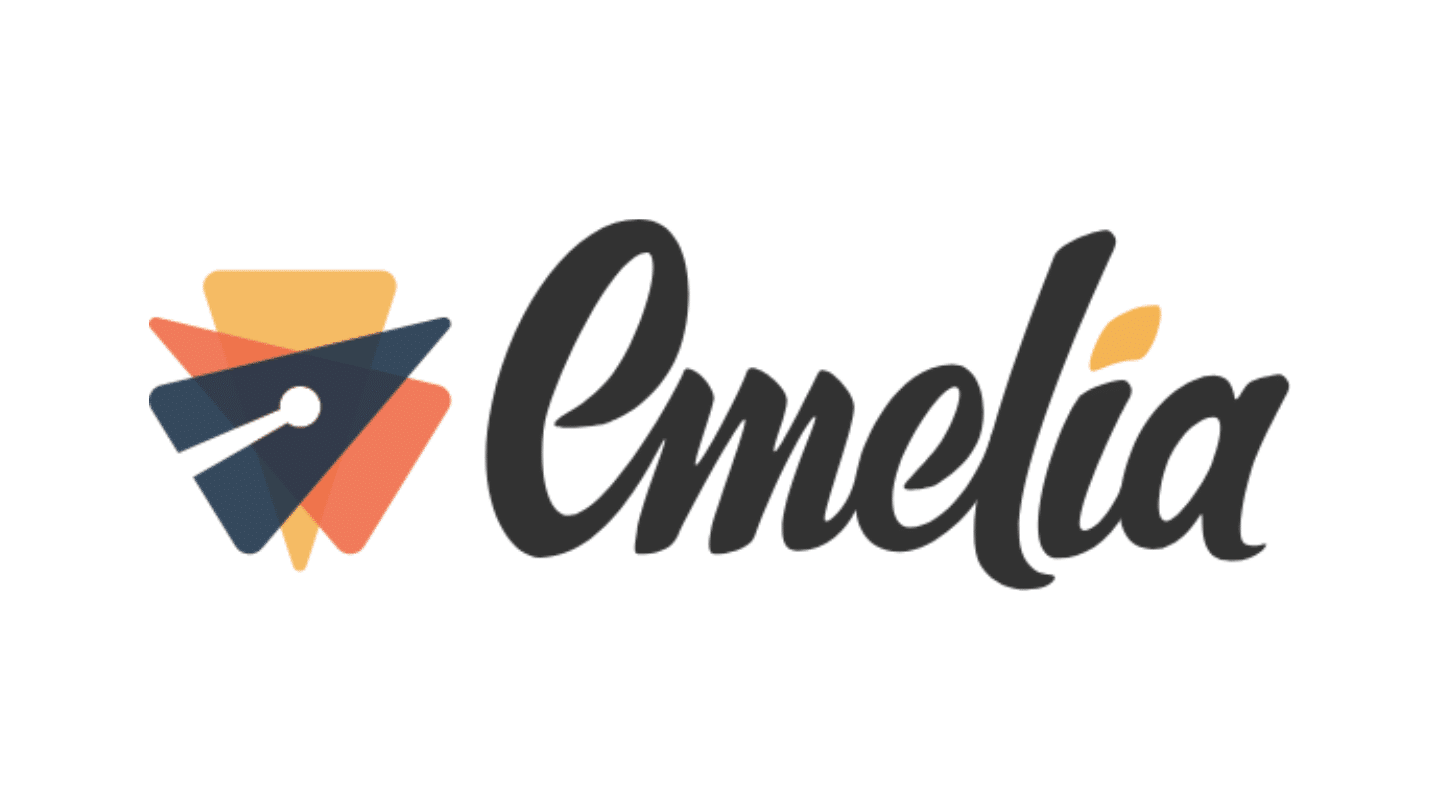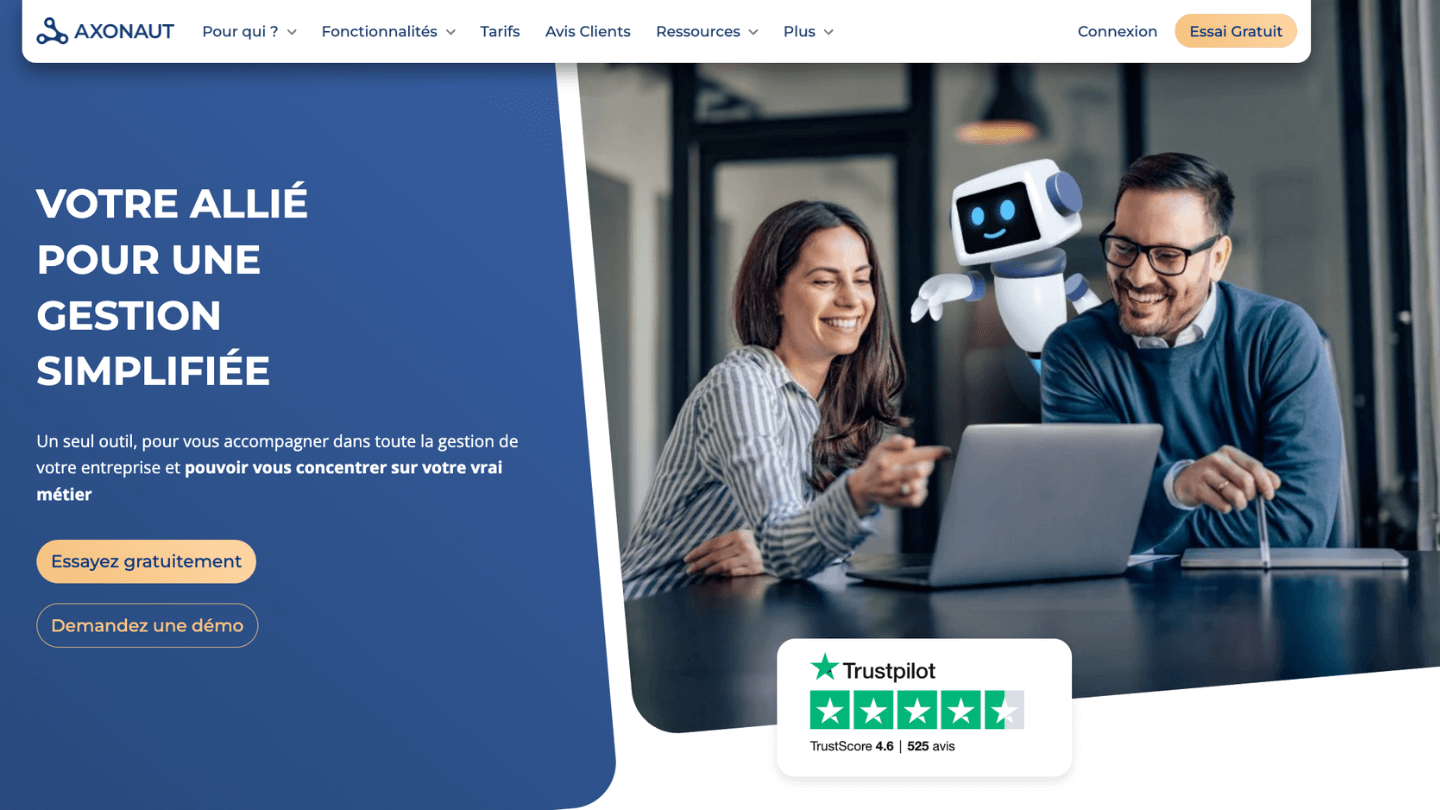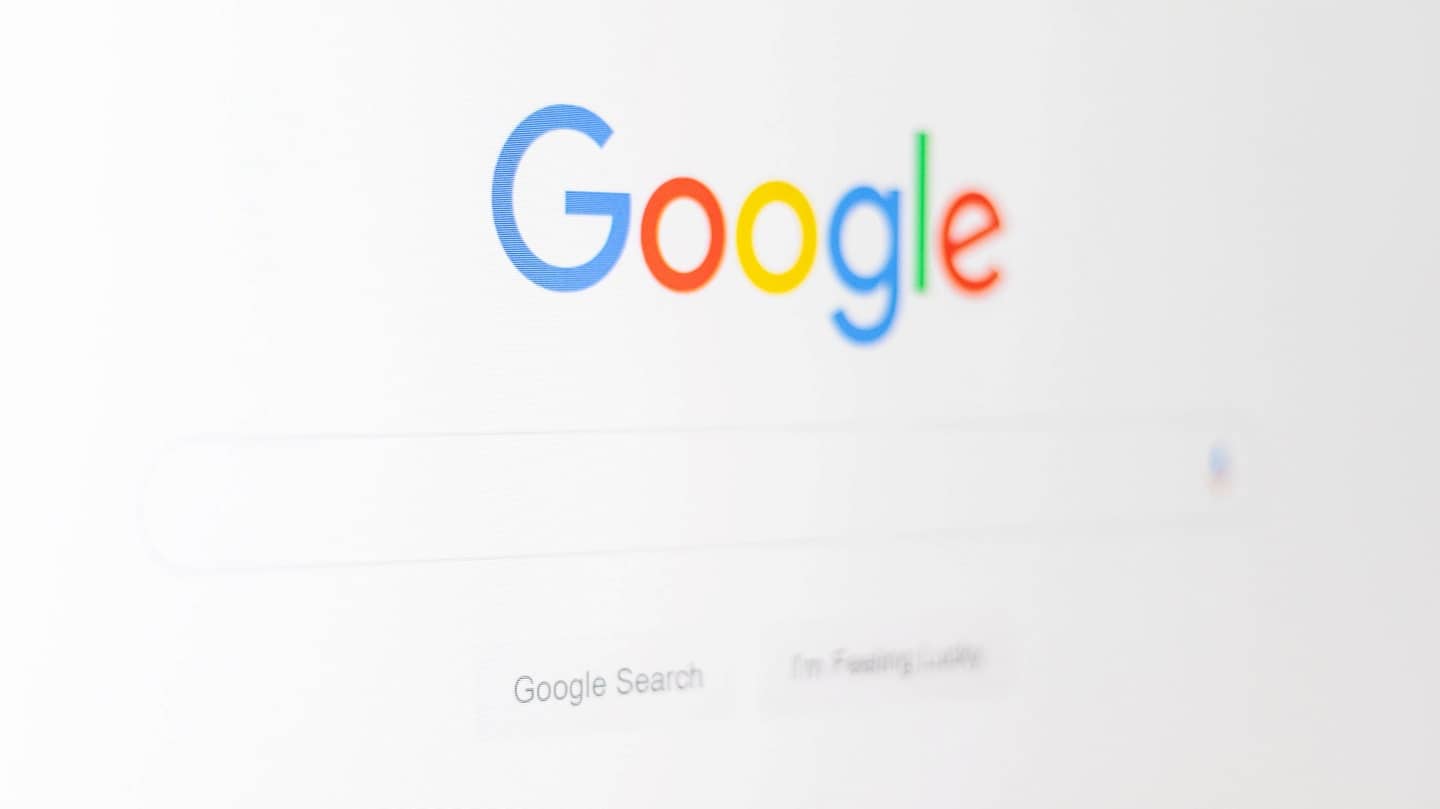Multi-channel allows you to increase the commercial pressure, while remaining below the threshold of acceptability of your targets. Be careful, however, to have a well-defined KPI and sales pitch. Otherwise, complicating your prospecting processes will only drown out the fish.
In this article, 7 concrete examples of multi-channel prospecting sequences. Most of the examples here focus on email & cold calling, and not so much on the new, somewhat "fashionable" channels. It’s up to you to adapt them to your persona to take advantage of the new modes of communication & new features that are regularly released (e.g. the linkedin voice message, even if it’s already a bit out of fashion).
Sommaire
#1 The classic outbound cadence
In B2B, a multi-channel sales prospecting sequence consists of a combination of e-mails and telephone calls. The objective is to do your best to establish contact with the prospect.
What next? Set up an appointment to talk to the prospect with the aim of moving them through your sales funnel. Here is an example of a cadence you can use:

In the beginning, vary the time you send your emails or make your phone calls. This will give you a better chance of making contact from the start, as the time you send your emails and make your calls is very subjective.
If you have managed to make contact with the person (and have not received a definite ‘no’), continue to follow this lead until you get a clear answer.
#2 Outbound rate to sell service
Selling services is a different world. Here the pace will depend on the type of services you sell.
For example, if you sell insurance or financial services, adjust your cadence to contract renewal dates or tax deadlines. Here is a much more focused cadence than the first for service companies seeking new prospects:
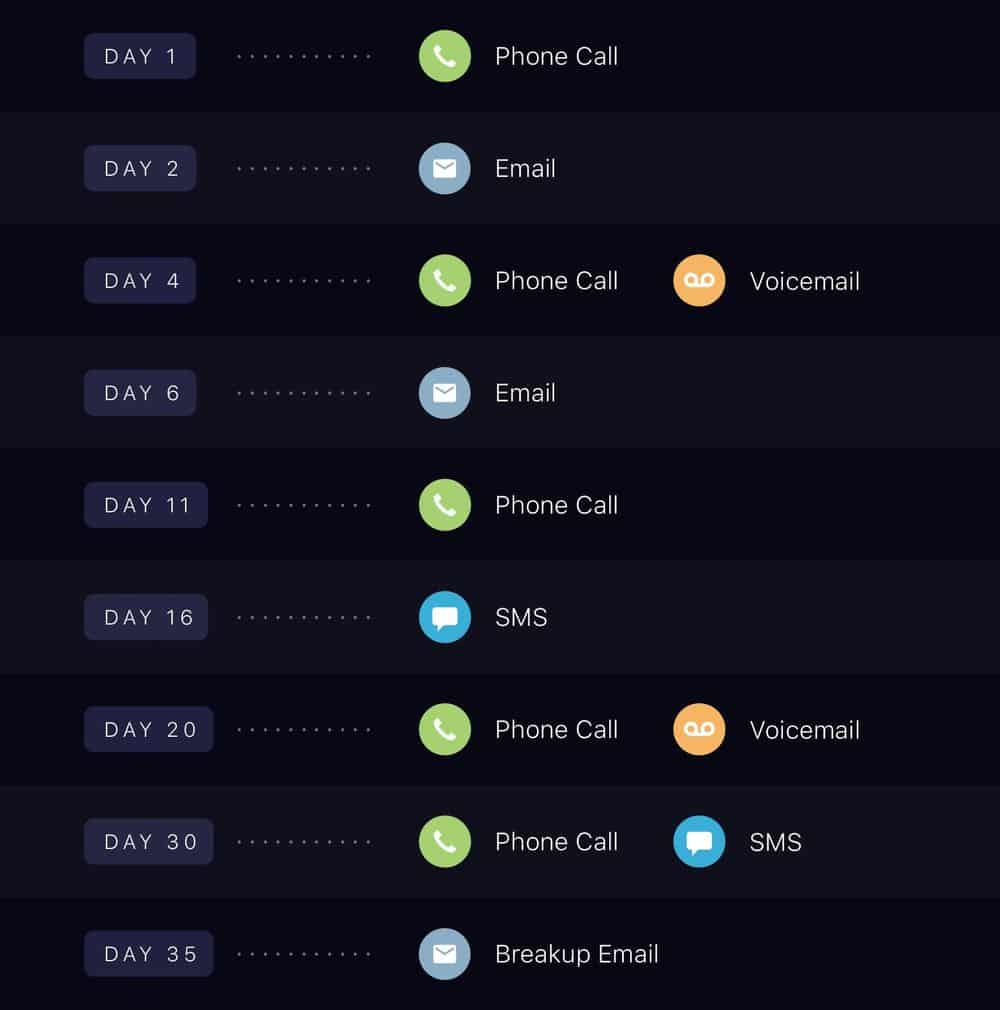
#3 The pace of Max Altschuler (Saleshacker.com)
Pace in multi-channel prospecting is a much discussed topic, and there is no right or wrong choice. Conduct tests to analyse the most promising results.
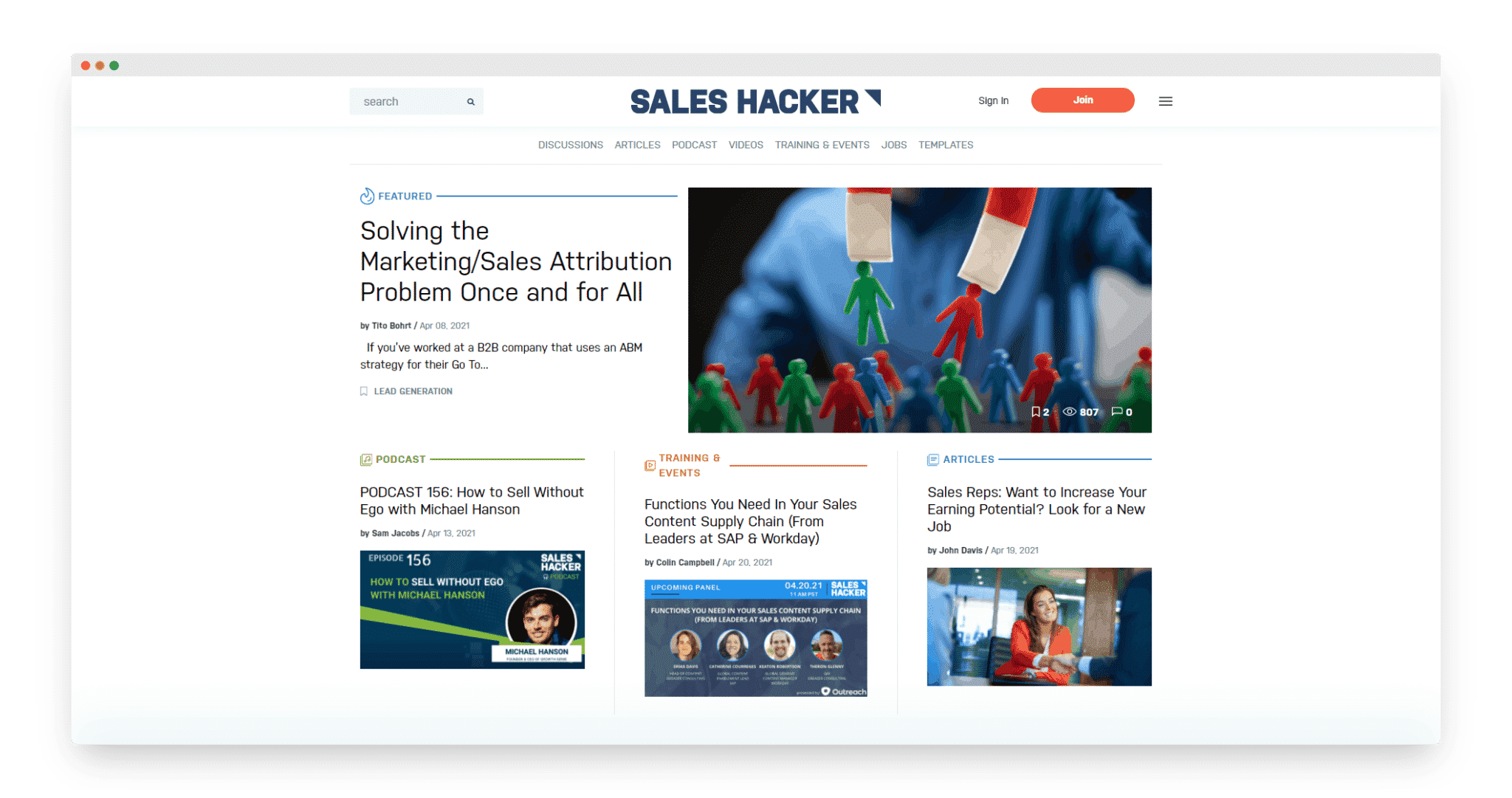
According to Max Altschuler, CEO of Saleshacker.com (one of the leading B2B sales companies in the US in 2021), this is the “ideal” pace:
- Day 1: E-mail/Inmail,
- Day 3: E-mail in the morning, phone call in the afternoon,
- Day 5: Phone call in the morning, phone call with voice message in the afternoon,
- Day 7: E-mail in the morning, phone call with voice message in the afternoon,
- Day 10: E-mail and phone call in the morning.
The number of touchpoints in your sequence is the subject of endless debate. Hubspot uses seven, and says that after nine, your performance becomes diminishing.
They may even end up in spam. If you don’t get any response, try taking a break for three to six months before trying again.
#4 The ultra-aggressive pace of close.com
The crucial step in this sequence is to leave a voice message on the first day. That way, on the second call, the recipient will know who you are and will be less likely to reject the call.
- Day 1: phone call (with voice message) + an e-mail,
- Day 3: phone call,
- Day 5: InMail on Linkedin,
- Day 7: phone call (with voice message) + an e-mail,
- Day 10: E-mail with SMS (if you have permission),
- Day 11: phone call,
- Day 14: Phone call (with voice message) + addition on Linkedin with a message,
- Day 16: E-mail,
- Day 18: Phone call (with voice message) + e-mail breakup.
#5 The pace of g2Crowd
g2Crowd is a software evaluation site that has grown quite rapidly in the last few years. Note that sales cycles are much longer than 14 days, the sequence below shows an interesting and quite healthy approach to prospecting: 14 days at (very) high pressure to get a contact. Otherwise, lost.
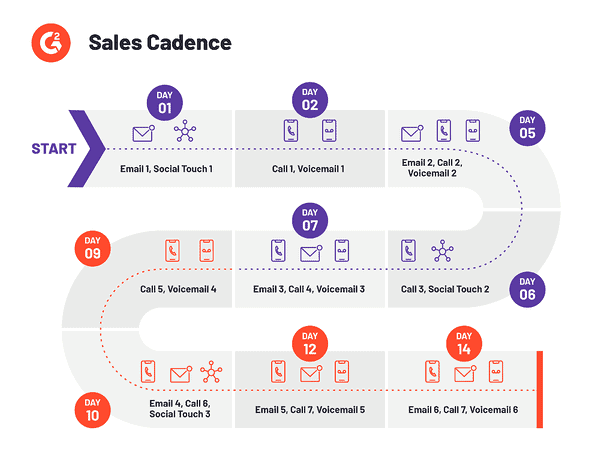
While not all sales cadences are alike, the general idea is the same: to be consistent, sequential and methodical with prospects, in the hope of converting them into customers. A typical cadence lasts between 5 and 22 days.
Yours may not look exactly like this example. However, the first and last day generally follow a similar pattern in all companies. Let’s look at them in a little more detail.
On the first day, contact the prospect via their social networks or send them a cold mail. Show them that you have researched their business and have something of value to offer.
The next day, follow up this email with a phone call and, if they don’t respond, leave a voice message. Make sure that the content of this message reflects what you said in your first e-mail.
On the last day of your sequence, if no relationship has been created, you will “break up” with the prospect. This will include your last email and phone call or voicemail. This is the final step in the sales prospecting plan.
Salesdorado’s advice
Remember that the purpose of these messages is to close your sales sequence, to remind the prospect of the challenge facing their business and how your solution can help them if they give you the opportunity. As far as break-ups are concerned, they should be positive and optimistic.
#6 The Steli Efti sequence (CEO @ Close.io)
When dunning, start by dunning very frequently and then decrease over time. Here is a general schedule for planning your dunning:
- Day 1: 1st reminder,
- Day 3: 2nd relaunch,
- Day 7: 3rd relaunch,
- Day 14: 4th relaunch,
- Day 28: 5th relaunch,
- Day 58: 6th relaunch,
- After day 58: once a month.
This is the calendar of reminder mails used by Steli Efti.
Follow-up by e-mail or phone?
This is the big question when it comes to following up on your prospect. Is it better to do it by e-mail, telephone or another channel?
- By email: email is the best way to get a positive response because you can follow up ad vitam aeternam without being (too) invasive!
- By telephone: If you want a quick answer, the telephone is the most effective way. On the other hand, it is much more intrusive and the risk of getting an answer like “maybe” instead of “no” is much higher.
- In person: this is the “double or nothing” method. Think carefully before you visit your prospect’s place of work. But doing it once and saying “I was in the neighbourhood, this was a chance to …” can sometimes be valuable.
- By SMS: If you want a higher response rate, SMS may be the answer. Like the phone call, SMS is quite intrusive, so use this tactic sparingly.
- On social networks: this is still a relatively uncommon method. Retweeting, commenting, sending an invitation on Linkedin etc. are all actions you can take to stay in your prospect’s mind.
Salesdorado’s advice
Sometimes you might think that contacting someone who doesn’t respond in public will “force” them to respond. By commenting in a Linkedin post for example, or tweeting publicly. In truth, you are taking a considerable risk, and you are extremely unlikely to make it work when you do this:
- Considerable risk because a slightly ill-intentioned person can humiliate you (and your company) in public. Unless you are 1000% sure and certain of your targeting and hook, it will be very easy to show you why your message is not relevant. And it’s quite likely that this is the reason why you still haven’t received a response.
- Extremely unlikely to work because you are trying to invoke shame in your prospect. Steli Efti says it best, but always avoid negative emotions in your communications as much as possible. They are never a driving force. You don’t do anything out of shame, you decide not to. When you want to move a lead to action, only positive emotions will help you do so.
#7 Example of cadence for complex sales
The rate at which you sell will change dramatically depending on who in the company you are trying to reach.
To be successful in selling to companies, get buy-in from several stakeholders. To do this, be active at all levels of the company hierarchy.
In B2B sales, account mapping can help you identify important stakeholders and end-users of your product/service.
Once this is done, set up a cadence with several touch points with the different levels of hierarchy. Here is an example of how it works, from the top down:
